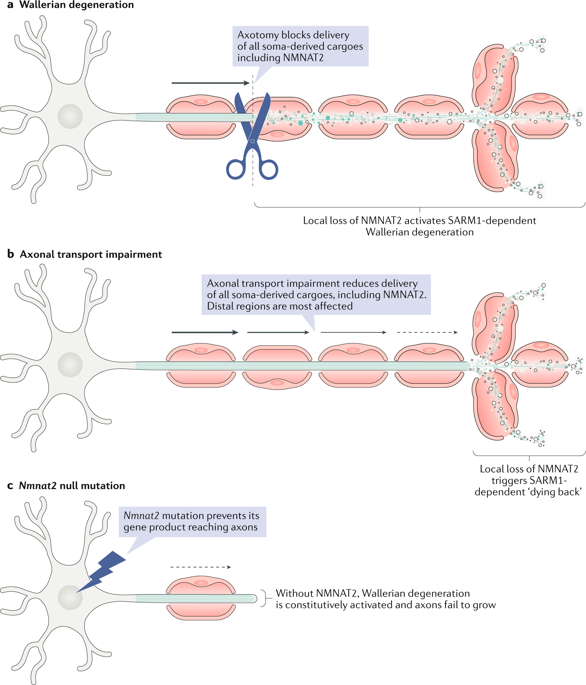当前位置:
X-MOL 学术
›
Nat. Rev. Neurosci.
›
论文详情
Our official English website, www.x-mol.net, welcomes your
feedback! (Note: you will need to create a separate account there.)
Programmed axon degeneration: from mouse to mechanism to medicine.
Nature Reviews Neuroscience ( IF 28.7 ) Pub Date : 2020-03-09 , DOI: 10.1038/s41583-020-0269-3 Michael P Coleman 1, 2 , Ahmet Höke 3
Nature Reviews Neuroscience ( IF 28.7 ) Pub Date : 2020-03-09 , DOI: 10.1038/s41583-020-0269-3 Michael P Coleman 1, 2 , Ahmet Höke 3
Affiliation

|
Wallerian degeneration is a widespread mechanism of programmed axon degeneration. In the three decades since the discovery of the Wallerian degeneration slow (WldS) mouse, research has generated extensive knowledge of the molecular mechanisms underlying Wallerian degeneration, demonstrated its involvement in non-injury disorders and found multiple ways to block it. Recent developments have included: the detection of NMNAT2 mutations that implicate Wallerian degeneration in rare human diseases; the capacity for lifelong rescue of a lethal condition related to Wallerian degeneration in mice; the discovery of 'druggable' enzymes, including SARM1 and MYCBP2 (also known as PHR1), in Wallerian pathways; and the elucidation of protein structures to drive further understanding of the underlying mechanisms and drug development. Additionally, new data have indicated the potential of these advances to alleviate a number of common disorders, including chemotherapy-induced and diabetic peripheral neuropathies, traumatic brain injury, and amyotrophic lateral sclerosis.
中文翻译:

程序性轴突退化:从小鼠到机制再到药物。
沃勒变性是程序性轴突变性的普遍机制。自发现沃勒变性缓慢 (WldS) 小鼠以来的三个十年中,研究已经对沃勒变性的分子机制产生了广泛的了解,证明了它与非损伤性疾病有关,并找到了多种阻止它的方法。最近的进展包括: 检测到与人类罕见疾病中的沃勒变性有关的 NMNAT2 突变;终生拯救与小鼠沃勒氏变性相关的致命疾病的能力;在 Wallerian 通路中发现“可成药”酶,包括 SARM1 和 MYCBP2(也称为 PHR1);以及蛋白质结构的阐明,以推动对潜在机制和药物开发的进一步理解。此外,
更新日期:2020-03-09
中文翻译:

程序性轴突退化:从小鼠到机制再到药物。
沃勒变性是程序性轴突变性的普遍机制。自发现沃勒变性缓慢 (WldS) 小鼠以来的三个十年中,研究已经对沃勒变性的分子机制产生了广泛的了解,证明了它与非损伤性疾病有关,并找到了多种阻止它的方法。最近的进展包括: 检测到与人类罕见疾病中的沃勒变性有关的 NMNAT2 突变;终生拯救与小鼠沃勒氏变性相关的致命疾病的能力;在 Wallerian 通路中发现“可成药”酶,包括 SARM1 和 MYCBP2(也称为 PHR1);以及蛋白质结构的阐明,以推动对潜在机制和药物开发的进一步理解。此外,































 京公网安备 11010802027423号
京公网安备 11010802027423号